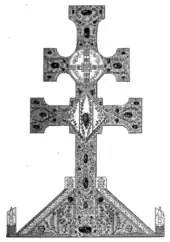Saint-Martin de Limoges (or Saint-Martin-lez-Limoges) was a Benedictine monastery in Limoges from 1012 and a house of Feuillants from 1624 until 1791.

For the early years of the monastery before its re-foundation, there is no other source than the 13th-century chronicle of the Abbot Pierre Coral. He records that a monastery dedicated to Martin of Tours was founded around 640 by the parents of Saint Eligius, and that the latter's brother, Alicius, was the first abbot.[1] It was subsequently destroyed by Pippin I of Aquitaine during the a civil war and then again by Vikings.[1][2] How much of this history is true is impossible to say, but there was certainly an abandoned church outside the walls by the year 1000.[3]
Bishop Hilduin of Limoges established a Benedictine monastery at that place in 1012. This is mentioned by a contemporary, Ademar of Chabannes.[2] Hilduin and his brother, the abbot of Saint-Martial, gave gifts to the monastery. The bishop endowed it with the relics of Saint Justus.[4] He may even have procured royal and papal protection for his new foundation.[5] He was buried at Saint-Martin.[6] Pierre Coral claims that he still left the monastery poor and small.[4] Soon after, Bishop Jordan praised the monastery before the peace council of 1031.[7]
The first abbot, Rudolf, came from the abbey of Tulle. The second, Berengar, came from Saint-Augustin-lès-Limoges and died en route. The third, Donadieu, was consecrated in December 1074. Tradition associated him with the monastery's acquisition of a relic of Martin of Tours. The fourth abbot, Jordan, came from Vierzon. He resigned and was succeeded by Gerard.[8] Gerard, a monk of Tulle, was succeeded in 1134 by the first abbot elected from among the monks of Saint-Martin, William I.[9]
In 1155, William was succeeded by Pierre de Pierrebuffière, a native of the Limousin and the prior of Sauxillanges.[10] During his abbacy, in 1182, the monastery was heavily damaged when Henry the Young King suppressed a local rebellion. The monks were given refuge in the city by Saint-Martial. Pierre soon left for Cluny and by 1195 the monks had elected William II. William died the following year and Richard the Lionheart imposed the provost of Saint-Augustin, Raymond de Treignac, as abbot. Although Richard favoured rebuilding the monastery, nothing was done in Raymond four or five years as abbot.[11] The church was rebuilt by 1235. In 1247, Pierre Coral became abbot. He left to become abbot of Tulle in 1276.[12]
During the Wars of Religion, the monastery was damaged by Huguenots in 1548 and 1563. It was repaired by the commendatory abbot Marchandon.[13] In 1622, the Benedictines of Saint-Martin ceded their house to Marchandon, who converted it into a house of Feuillants by 1624 under the name Saint-Martin-Saint-Laurent.[6][13] In 1791, the building was acquired by the government.[6] It became the headquarters of the 12th Army Corps. Today no trace of the monastic building remains.[13]
Notes
- 1 2 Lecler 1890, p. 410.
- 1 2 Jones 2009, p. 153.
- ↑ Becquet 1979, p. 377.
- 1 2 Jones 2009, pp. 164–165.
- ↑ Jones 2009, p. 168n.
- 1 2 3 Lecler 1890, p. 411.
- ↑ Jones 2009, p. 134.
- ↑ Becquet 1979, p. 378.
- ↑ Becquet 1979, p. 380.
- ↑ Becquet 1979, p. 381.
- ↑ Becquet 1979, p. 382.
- ↑ Becquet 1979, p. 383.
- 1 2 3 Besse 1912, p. 201.
Bibliography
- Besse, J.-M. (1912). Abbayes et prieurés de l'ancienne France. Vol. 5. Paris.
{{cite book}}: CS1 maint: location missing publisher (link) - Becquet, Jean (1979). "Les premiers abbés de Saint-Martin de Limoges (XIe–XIIe siècles)". Revue Mabillon. 59: 375–392.
- Bonnaud, Louis (2001). "Les reliques de l'ancienne abbaye Saint-Martin-lez-Limoges". Bulletin de la Société Archéologique et Historique du Limousin. 129: 159–177.
- Guibert, Louis (1898). "Les sépultures de l'abbaye de Saint-Martin-lès-Limoges et la crosse de l'archevêque Geoffroi". Bulletin de la Société Archéologique et Historique du Limousin. 46: 242–253.
- Lecler, André (1890). Chroniques ecclésiastique du Limousin. Tulle.
{{cite book}}: CS1 maint: location missing publisher (link) - Jones, Anna T. (2009). Noble Lord, Good Shepherd: Episcopal Power and Piety in Aquitaine, 877–1050. Leiden: Brill.